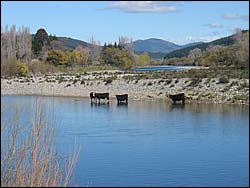Faecal bacteria in the Motueka River
Research Status: Ongoing |
Cows in the Motueka River |
Introduction
Storm events can mobilise and transport large amounts of contaminants from sources of pollution on land, threatening water uses downstream. Microbes such as bacteria, viruses, and protozoans of faecal origin that are mobilised during storm flows impact bathing and shellfish harvesting (and shellfish aquaculture) in coastal waters that receive contaminated river plumes.
The Motueka River has a range of land uses over its 2000 km2 catchment, including pastoral farming. The latter is expected to be the dominant source of faecal microbes in this river, rather than human sewage.
Research Approach
We have examined faecal indicator bacteria, turbidity (water cloudiness) and flow in the Motueka River, in order to better understand sources and transport of faecal pollution and downstream effects.
Continuous flow and turbidity are recorded continuously at Woodmans Bend near the mouth of the Motueka River. An automatic sampler is programmed to ‘trigger’ sampling when river level rises above a threshold. We intercepted autosamples collected for sediment analysis over storm events for a calendar year (2003-2004), and sub-sampled for analysis of the faecal indicator bacterium, E. coli as an index of faecal pollution. Regular (monthly) sampling for E. coli in the river was already underway (and is continuing).
Research Results
The Motueka River is fairly unpolluted by faecal microbes compared to New Zealand rivers generally, with concentrations almost always suitable for swimming under baseflow conditions. However, as has been found elsewhere, faecal contamination levels were very much higher (E. coli bacteria concentrations 100 times or more higher) during stormflows and tended to be higher on the rising limb of the storm events (when water was usually not suitable for swimming) than when water level was falling. Swimming during storm events is not recommended - and not just because of the microbiological status of the water!
As we expected, almost all (98%) of the annual E. coli load (E. coli per year) delivered to Tasman Bay is exported during rainstorm events.
The NIWA E. coli data has been used to calibrate a model on river microbial dynamics developed by Jeremy Wilkinson, based, until recently, at Cawthron Institute.
Recent Publications
Recent Presentations
BMPs, BEPs and Guidelines
| Title | Description |
| Microbiological Water Quality Guidelines for Marine and Freshwater Recreational Areas |
From guide: The Microbiological Water Quality Guidelines for Marine and Freshwater Recreationa...More » |
| Drinking–water standards for New Zealand |
From website: The Drinking–water Standards for New Zealand 2005 contains comprehensive i...More » |
| Dairying and the Environment: Managing Farm Dairy Effluent |
From manual: The purpose of this manual is to assist dairy farmers and farm management special...More » |
| A Guide to Managing Farm Dairy Effluent – Tasman/Marlborough |
From booklet: This booklet provides best management practices for the main systems currently o...More » |
| Farm Dairy Effluent: Best practice guidelines |
From website: To help dairy farmers manage farm dairy effluent, the Farm Dairy Effluent bookle...More » |
Primary Contacts:
.jpg)
|
Rob Davies-Colley
Email Phone: (07) 856-1725 Fax: (07) 856-0151 More details» |
Institute National Institute of Water and Atmospheric Research (NIWA) |
Expertise water quality (esp. optics of water, faecal indicator bacteria), stream habitat, riparian ecology |

|
Rob Merrilees
Email |
Institute NIWA |
Expertise Environmental monitoring |